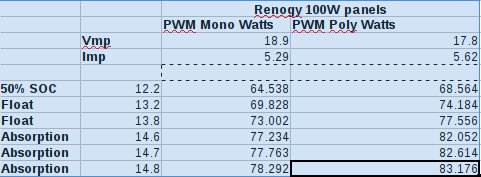backchannel: making the best of a bad (solar) situation
In this reddit thread , OP has inherited a solar configuration that isn’t meeting their needs.
> I really only have space for one more panel
OP is space-limited. This immediately brings to mind mppt charging, high efficiency panels, maximizing solar yield, and reducing loads.
> I just need a little bit more power for my load
Ok, let’s see what we can do.
the gear
-
100w panel (per the post), flex mono (visually identified)
-
2x 75Ah AGM batteries, which I suspect are SigmasTek SP12-75 NB Battery, based on partial pics
-
A shunt charge controller, possibly this 20A example
-
a 1000w inverter (per the post)
Analysis
The 100w:150Ah configuration is underpaneled. OP appears to understand this. The battery bank may already be murdered.
Shunt controllers are fine; they are not a good match for mono panels on which they get about 6% lower output:

The batteries are incorrectly wired for balanced parallel use. The “first” battery will be doing most of the work and will age/fail faster.
The inverter is ludicrously oversized for the system. I also judge it’s not being used wisely as there’s nothing plugged into it in the pic but it’s still powered on.
A note on inverter sizing: Inverters are sized to the max load one expects to place on them. Panels are then added to support the battery bank during use. For solar-only charging:
-
flooded banks need a 1:1 ratio between panel and inverter to support the bank. E.g. 500w of panel for 500w of inverter.
-
AGM / lithium have lower internal resistance and therefore handle heavy loads better. Because of this, they only require a 1:2 ratio between panel and inverter. E.g. 500w of panel to 1000w of inverter.
OP has way, way too much inverter for that size of bank and panel.
recommendations
Here is what I would do to increase the usability of this setup.
-
take stock of the present system: identify manufacturer, model, specs. Write up somewhere so can paste the info in later if needed (as in a thread like that)
-
rewire the batteries in parallel correctly (ie, pos and neg come off separate batteries). Cost: free.
-
The battery has info printed on it that says it should be charged to 14.4v - 15.0v for deep cycle use. Increase the voltage on the existing controller to 14.8v to get more power from the panel, store more power in the battery, and give the battery a chance of getting charged. Cost: free.
-
stop using the inverter if possible and power it off when not in use (nothing plugged in but powered on in pic). Cost: free.
-
see what happens. If power needs met, yay.
-
if power needs not met, install a voltage sensing regulator to charge from the alternator – adding alternator charging to solar makes a huge difference. Cost: $100 with wiring and fuses.
-
see what happens. If power needs met, yay.
-
if power needs not met, install an inexpensive 10A mppt controller, like this. Has a meter/readout for configuration and a temp probe. This will increase overall yield by ~15%. Set to Vabs == Vfloat == 14.8v until we know the batt is being charged. Possibly reduce float into the 13s later. Cost: $90.
-
see what happens. If power needs met, yay.
-
if power needs not met, add in another 100w panel identical to existing one in parallel. If identical panel is not available, run the panels in parallel then serial to see which works best with the mismatched panels. The 10A controller will be overpaneled at that point but will work fine. Cost: $100. If OP wants 300w then use 20A mppt.